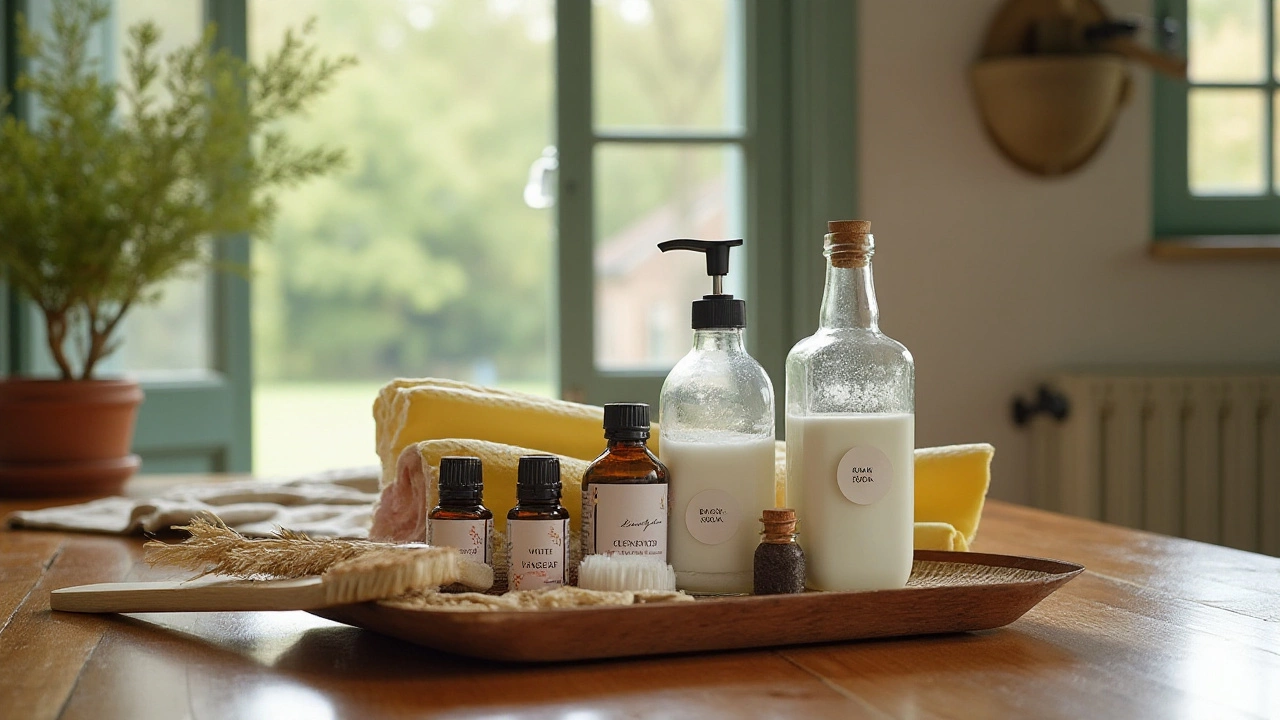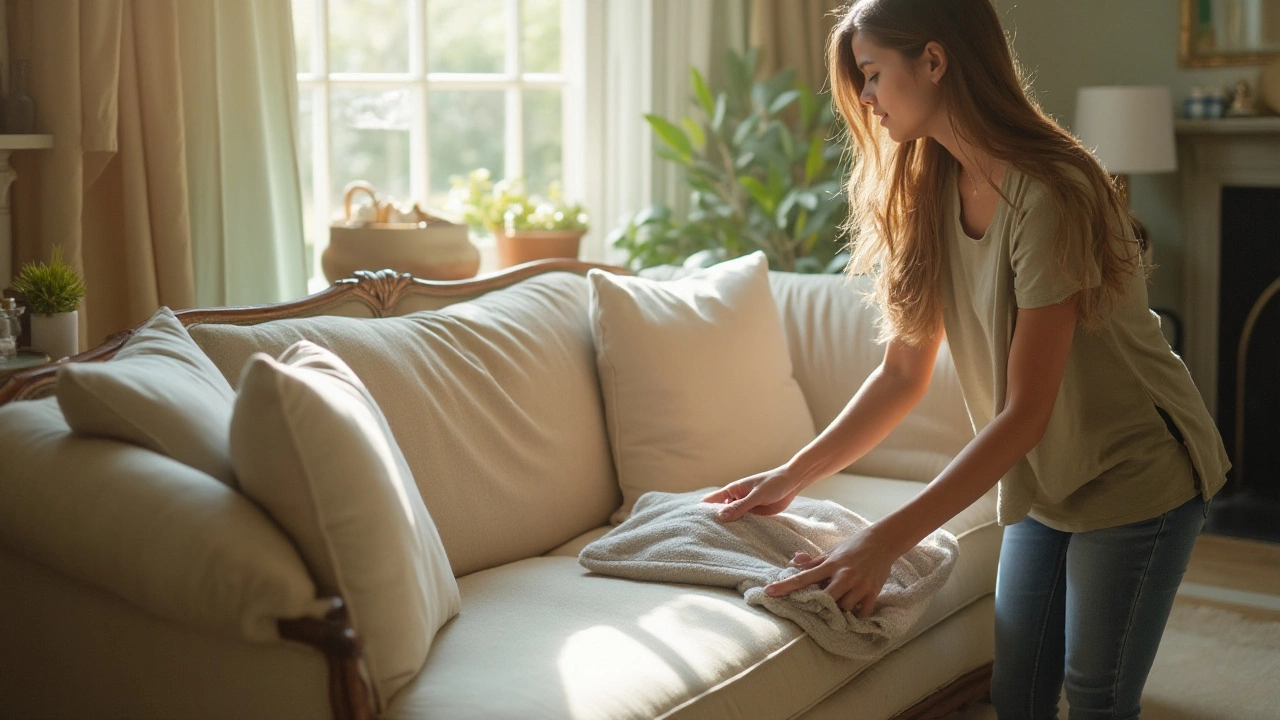Picture this: your couch stands as the centerpiece of your living room, inviting you to unwind after a long day. Yet, without removable covers, keeping those cushions fresh can feel like a daunting task. Fear not, for cleaning can be simpler than it seems.
Before diving into cleaning, it's crucial to know the fabric type of your cushions. This knowledge guides your cleaning choices and avoids potential mishaps. Armed with the right cleaning supplies, and a bit of patience, you can maintain the look and feel of your cushions.
In this article, we unravel the secrets of easy cleaning methods, explore DIY cleaning concoctions you can whip up at home, and share tips to protect your beloved couch from future mishaps. With these insights, you’ll turn cleaning day into a straightforward routine, ensuring your couch looks inviting for years to come.
- Understanding Fabric Types
- Essential Cleaning Supplies
- Step-by-Step Cleaning Process
- Homemade Cleaning Solutions
- Maintaining Your Couch Cushions
Understanding Fabric Types
Taking the first step in cleaning your couch cushions involves diving into the world of textiles. Different fabrics demand different care techniques, and understanding these nuances is crucial for anyone aiming to maintain their sofa's quality. From natural fibers like cotton and linen to synthetics like polyester and microfiber, each material has its own personality and set of rules. Cotton, for example, is favored for its breathability and comfort, yet it is also quite absorbent, making it more susceptible to stains. On the other hand, polyester is highly resistant to wrinkles and easy to clean, but it can attract lint. By knowing the fabric type, cleaning becomes an art rather than a chore.
Each couch cushion fabric reacts differently to cleaning agents. Leather, for instance, adds an elegant touch but requires special care with conditioning agents to prevent cracking and drying. Upholstery tips often suggest using a conditioner twice a year for leather to retain its sheen. Microfiber is a true marvel with its ability to repel stains, making spot cleaning a breeze. Yet, without regular cleaning, oils and residue can become lodged in its fibers. Homeowners often underestimate these subtleties, resulting in decreased longevity. According to a study by the Textile Rental Services Association, about 30% of people use incompatible cleaning methods on their fabrics, leading to quicker wear.
To make the cleaning process easier, many manufacturers provide a cleaning code on the cushion’s label. These codes, often a combination of letters such as 'W', 'S', 'SW', or 'X', indicate which cleaning techniques and products are safe to use. 'W' typically denotes water-based cleaning, a common option for fabrics like cotton. 'S' stands for solvent-based cleaning suitable for more delicate fabrics like silk. The 'SW' combination allows for both, offering more flexibility, while 'X' means a professional intervention is best. Recognizing these codes can be the key to saving time and effort, while ensuring you don’t inadvertently ruin the material.
A quote from the respected cleaning expert, Martha Stewart, highlights the importance of fabric knowledge:
"Understanding the fabric is the foundation of successful cleaning. It’s not just about removing the stain; it's about preserving the essence of your furniture."Following her advice, knowing the nuances of your fabric turns every cleaning session into an act of preservation. Moreover, with modern advancements in fabric technology, innovative blends have emerged, combining the best of both worlds. This includes performance fabrics known for their durability and stain resistance, ideal for households with children or pets. These blends often require tailored cleaning approaches, which can be easily navigated if the owner takes the time to learn about them.
In conclusion, understanding your fabric type is not just beneficial but critical. The longevity and appearance of your cushions hinge on small details like these. By aligning cleaning methods to fabric types, homeowners can enjoy their furniture's beauty and function without the worry. Knowing these facts ensures that a pleasant space remains just that—a haven of comfort and style.
Essential Cleaning Supplies
When dealing with couch cleaning, particularly for those cushions that defy easy removal, the right tools can make all the difference. A proactive approach ensures not only cleanliness but also extends the life of your beloved upholstery. Let's explore the essential supplies you'll need to get the job done efficiently. First and foremost, a trusty vacuum cleaner with an upholstery attachment is your go-to ally. It helps in extracting dust, hair, and allergen particles that might have embedded themselves within the fabric fibers. Regular vacuuming is imperative, and opting for models with strong suction yet gentle brushes can help rescue your cushions from unwanted dirt while maintaining the fabric's integrity.
An ingredient not to overlook is a safe fabric cleaner suited to your couch's material. Whether it's a commercial product or a homemade concoction, being mindful of the ingredients and their compatibility with fabric type is crucial. Mixing solutions like mild dish soap with warm water can serve as an effective cleaner for minor stains. A bottle of vinegar does wonders too, acting as a natural deodorizer and stain remover.
Mary Gagliardi, Cleaning Expert for Clorox, says, "A cleaning opportunity arises when you combine science with household supplies, creating magical removers for fabric stains."Having a fabric-specific cleanser allows you to tackle persistent stains head-on with a precise formula that doesn't compromise the material.
Another must-have supply lies in the humble microfiber cloth. Its gentle texture makes it ideal for blotting stains rather than rubbing them deeper into the cushion. Given its ability to absorb more than its weight in liquid, it’s a reliable choice for quick spot treatments. Paired with the microfiber is a soft-bristle brush, often a game-changer in loosening dried stains or delicately working in cleaning solutions without damaging the fibers. For a thorough clean, a spray bottle filled with water or your homemade cleaner aids in evenly distributing the cleaning agent across the surface, ensuring no area is left unattended.
In our quest for cleanliness, drying shouldn't be disregarded. A small fan or a dedicated hairdryer set to a cool setting can speed up drying after spot-cleaning, preventing musty odors. To wrap things up, stock up on baking soda for its natural deodorizing properties, and sprinkle it lightly on cushions before vacuuming to keep them smelling as fresh as a daisy. If you're inclined towards a more technical approach, steam cleaners offer a deep-cleaning experience that rejuvenates fabric by removing germs and allergens effectively.
An eye on preparation with these supplies guarantees that you'll handle any spills or stains with confidence, knowing you've invested time in understanding the nuances of couch cleaning and maintained your upholstery in impeccable condition. By utilizing the appropriate tools and methods, maintaining the allure and cleanliness of your non-removable cushion covers becomes a hassle-free endeavor.

Step-by-Step Cleaning Process
When it comes to keeping your couch pristine, a well-thought-out cleaning process is key. Let's dive into a structured approach to removing dirt and spills from couch cushions with non-removable covers. Start by giving those cushions a good vacuuming. This initial step is crucial as it removes breadcrumbs, pet hair, and any other loose debris that might be lurking in the crevices of your fabric. Use a brush attachment to gently glide over the surface, ensuring you don’t miss those often-neglected areas like seams and corners. It’s the best way to lay the groundwork before introducing any liquid cleaning solutions.
Next up, identify and target those pesky spots and stains. This requires a bit of patience but pays off tremendously. Employ a mild detergent mixed with water for most upholstery materials. Before applying, test this concoction on an inconspicuous area to ensure it doesn’t cause discoloration—a vital step to safeguard against accidental damage. An important tip is to work from the perimeter of the stain towards the center, which minimizes the stain's spread and helps maintain your cushion's upholstery integrity.
One unconventional but effective approach is using steam cleaning. Steam cleaners are nifty machines, offering deep penetration cleaning without soaking your cushions. They lift dirt and bacteria that’s stubbornly settled into fibers like magic. Make sure to follow the directions provided with the steamer, as not all fabrics can withstand high temperatures. As Mary Johnson, a renowned expert in home textiles, once noted,
"The secret to keeping your couch cushions in prime condition is not just in the tools you use, but in understanding the material you're working with."
After cleaning comes the pressing matter of drying. Cushions that are damp or retain moisture become breeding grounds for mold and bacteria. Position your couch cushions in an upright manner in a well-ventilated space. Natural air-drying is ideal, so open up those windows and let the breeze do its thing. If the weather is not on your side, a gentle hairdryer at low heat works wonders to speed up the process. Avoid direct sunlight exposure for prolonged periods as it might fade certain fabrics.
Once completely dry, it's often beneficial to finish with a fabric protector spray. These sprays create a barrier against future spills, making routine maintenance exponentially easier. Apply the spray evenly, ensuring you cover all surfaces adequately. Don’t forget to allow ample time for the protector to set before using the sofa cushion again. To put it all simply, cleaning a couch cushion with non-removable covers requires both diligence and a systematic approach, but it can transform even the most dreaded cleaning days into a smooth-sailing endeavor.
Homemade Cleaning Solutions
Whipping up a homemade cleaning solution can be both cost-effective and kind to the environment, perfect for addressing stains or smells on upholstery. Surprisingly, many of the best cleaners are hidden in plain sight in your pantry. The advantage of these DIY remedies is that they are free from harsh chemicals, making them safer for the fabric, your health, and the planet. One of the all-time favorite cleaning agents is white vinegar. Thanks to its acidic nature, it effortlessly breaks down stains, kills bacteria, and even neutralizes unwanted odors.
To craft a simple cleaning mix, combine equal parts of warm water and white vinegar in a spray bottle. Be sparing when applying, as too much liquid might soak the cushion excessively. Lightly mist the affected area, then blot with a clean cloth to lift the stain. Giving the treated spot some time to dry completely is crucial. Cushion care demand an approach that delivers cleanliness without a trail of soap residue.
Baking soda is another hero in the DIY cleaning realm. Renowned for its deodorizing properties, baking soda shines in tackling odorous cushions. Generously sprinkle baking soda over your cushion, and let it settle for an hour or more. Its job done, simply vacuum it away, leaving your cushion smelling fresh.
"Baking soda's versatility as a cleaner and deodorizer cannot be understated," notes Sophie Emerson, an expert on sustainable living. "It pulls double duty without causing damage to your textiles."
When it comes to stain removal, a combination of mild dish soap, white vinegar, and water can work wonders. This solution is particularly effective against spots that are resistant to plain vinegar or baking soda. To make this cleaner, mix one tablespoon of liquid dish soap, a tablespoon of vinegar, and two cups of warm water. Apply this solution to your stain with a sponge, gently blotting and avoiding any scrubbing that could damage the fabric.
Lastly, not to be forgotten, lemon juice is known for its bleaching properties, making it invaluable for removing light stains. When mixed with cream of tartar to form a paste, it can work magic on lighter fabrics. Apply it to the stain, let it sit for around thirty minutes, then wipe away with a damp cloth. Of course, it's wise to patch-test any cleaning solution in an inconspicuous area of the cushion first, ensuring the fabric won’t fade or discolor. Delight in the power of these simple homemade options, and you'll keep your couch cleaning routine both effective and sustainable.

Maintaining Your Couch Cushions
Taking good care of your couch cushions, even those without removable covers, involves more than just occasional cleaning. It’s a blend of regular upkeep, clever practices, and using the right kind of protection. To start, couch cleaning isn't just about spot cleaning mishaps; it's about consistent action to prevent wear and tear over time. Regular maintenance can add years to your beloved piece of furniture and ensure it remains inviting. Start by establishing a routine of weekly vacuuming with a soft-brush attachment. This habit alone can prevent dust and debris from embedding deeply into the fabric, which can then become abrasive over time, wearing down surface fibers. Keeping your upholstery free of dust isn’t just about appearance; it’s about preservation, too.
Every few months, consider a deeper clean with a steamer. Steam cleaning is safe for most fabric types and gives your cushions a refresh. This process might also help in removing allergens such as dust mites. But, always test a small, inconspicuous area before proceeding with any thorough cleaning method. Additionally, mixing up your own gentle cleaning solution using readily available household items can be effective. A solution of white vinegar and water in equal parts can do wonders. It doesn't just clean; it also deodorizes cushions incredibly well. This natural blend is an excellent remedy for those worried about harsh chemicals affecting fabric longevity.
Now, let’s talk about placement. Try keeping couches away from direct sunlight as UV rays can gradually fade colors and weaken fibers. If rearranging isn’t an option, use thick, UV-protective curtains to filter harsh sun rays. Plus, rotating cushions weekly helps distribute wear evenly. You’d be surprised by how such a simple action can save your cushions from premature sagging. Flipping reversible cushions now and then ensures even usage, maintaining cushion shape and minimizing undue pressure in specific areas. Moreover, having a protective fabric spray applied after deep cleaning can act as a first line of defense against accidental spills and stains.
On maintaining quality, fabric protection isn’t just about the outer look. Look inside. Quality foam or down filling maintains its pep and comfort much longer than low-quality alternatives. Investing in good inner materials might seem more expensive up front but prove economical in the long run. Don’t forget to fluff your cushions weekly. This keeps them looking plump and cozy, ensuring each sit is as comfortable as the last. A relaxed cushion loses its original form and comfort fast.
Tips from Experts
Do expert insights make a difference? Certainly. Jane Spencer of ‘Upholstery Masters’ states,"Caring for your cushions extends beyond routine cleaning. It’s about creating the right environment for your couch to thrive. From air circulation to balanced humidity levels indoors, small details matter."Turning to the pros for advice or professional cleaning might be useful occasionally. Knowledge acquired from those who’ve dedicated years to upholstery care can be invaluable. Utilize their insights to maintain both appearance and integrity in your home’s upholstered jewels. Equipping yourself with the right knowledge helps ensure these household staples maintain their charm over time. It’s more about preserving memories, after all—a cozy atmosphere where comfort never fades.
